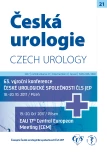Voiding dysfunction in patients with post-traumatic spinal cord lesion: the urologist’s role
Authors:
Klára Havlová
Authors‘ workplace:
Urologická klinika FN Motol, Praha
Published in:
Ces Urol 2017; 21(2): 129-138
Category:
Review article
Overview
Urological care of patients with a spinal cord lesion begins immediately after the injury. Approaches to treatment and to bladder evacuation are different in various phases of the spinal cord shock. It is important to diagnose the definitive type of lower urinary tract dysfunction and thus establish appropriate treatment. This helps to prevent complications and maintain a high quality of life.
KEY WORDS:
Spinal cord lesion, lower urinary tract dysfunction, overactive bladder, urinary tract infection, autonomic dysreflexia.
Sources
1. Hansen RB, Biering‑Sørensen F, Kristensen JK. Bladder emptying over a period of 10–45 years after a traumatic spinal cord injury. Spinal Cord 2004; 42(11): 631–637.
2. Wendesche P, Kříž J. Doporučené postupy péče v akutní fázi po poškození míchy [online]. 2005 [cit. 2016- 02-25]. Dostupné z: http://www.spinalcord.cz/_userfiles/dokumenty/doporucene‑postupy/ akutni_pece.pdf.
3. Statistiky. Česká společnost pro míšní léze ČLS JEP. [online]. [2016] [cit. 2016-02-25]. Dostupné z: http:// www.spinalcord.cz/cz/statistiky/
4. Ambler Z. Základy neurologie. 6. vyd. Praha: Galén, 2006.
5. Jirků H, Kyriánová A. Doporučené postupy pro ošetřovatelskou péči o pacienty po poškození míchy [online]. 2006 [cit. 2016-02-25]. Dostupné z: http://www.spinalcord.cz/_userfiles/dokumenty/doporucene-postupy/osetrovani.pdf.
6. Kirshblum C, Priebe MM, Ho CH, Scelza VM, Chiodo AE, Wuermser LA. Spinal cord injury medicine. 3. Rehabilitation phase after acute spinal cord injury. Archives of physical medicine and rehabilitation 2007; 88(3): S62–S70.
7. Kříž J, Rejchrt M. Autonomní dysreflexie – závažná komplikace u pacientů po poranění míchy. Cesk Slov Neurol N 2014; 77/110(2): 168–173.
8. Šámal V, Mečl J. Autonomní dysreflexie u pacientů po spinálním poranění. Ces Urol 2014; 18(4): 279–287.
9. Doležel J. Traumatické léze míšní. Urol. praxi 2004; 5(4): 146–155.
10. Krhut J, Doležel J, Zachoval R. Doporučené postupy pro urologickou péči o pacienty po poškození míchy. Praha: Svaz paraplegiků s podporou MZČR, 2006.
11. Yoshimura N, Chancellor MB. Neurophysiology of lower urinary tract function and dysfunction. Reviews in urology 2003; 5: S3.
12. Lukáš K. Chorobné znaky a příznaky. Grada Publishing a.s., 2010.
13. Krhut J, Doležel J, Doležil D, Zachoval R, Ženíšek J. Neurourologie. 1. vyd. Praha: Galén, 2005: 141.
14. Blok B, Pannek J, Castro Diaz D, et al. Guidelines on neuro‑urology. 2015.
15. Šámal V. Botulinumtoxin a jeho aktuální použití v urologii. Ces Urol 2009; 13(3): 199–206.16. Cone EB, Ellsworth P. Neurogenic detrusor overactivity: an update on management options. RI Med J 2013; 96(4): 38–40.
17. Ghei M, Marai BH, Miller R, et al. Effects of botulinum toxin BoNT/A on refraktory detrusor overactivity: a randomised, double blind, placebo‑controlled, crossover trial. J Urol 2005; 174: 1873–1878.
18. Consortium for Spinal Cord Medicine. Bladder management for adults with spinal cord injury: a clinical practice guideline for health‑care providers. J Spinal Cord Med. 2006; 29(5): 527–573.
19. Perkash I. Transurethral sphincterotomy provides significant relief in autonomic dysreflexia in spinal cord injured male patients: long‑term followup results. J Urol. 2007 Mar; 177(3): 1026–1029.
20. Vapnek JM, Couillard DR, Stone AR. Is sphincterotomy the best management of the spinal cord injured bladder? J Urol. 1994; 151(4): 961–964.
21. Krhut J. Botulotoxin – struktura, mechanizmus účinku a klinické použití. Urol. praxi 2006; 5: 278–282.
22. Mackerle Z, Brichtová E, Zerhau P, et al. Neurostimulace, neuromodulace a neurotizace v terapii neurogenního močového měchýře. Cesk Slov Neurol N 2015; 78/111(1): 83–87.
23. Evans CT, Lavela SL, Weaver FM, et al. Epidemiology of hospital-acquired infections in veterans with spinal cord injury and disorder. Infect Control Hosp Epidemiol. 2008; 29: 234–242.
24. National Institute on Disability and Rehabilitation Research (NIDRR) consensus statement, January 27–29, 1992: the prevention and management of urinary tract infection among people with spinal cord injuries. J Am Paraplegia Soc. 1992; 15: 194–204.
25. García Leoni ME, Esclarín de Ruz A. Management of urinary tract infection in patients with spinal cord injuries. Clin Microbiol Infect. 2003; 9: 780–785.
26. Massa LM, Hoffman JM, Cardenas DD. Validity, accuracy, and predictive value of urinary tract infection signs and symptoms in individuals with spinal cord injury on intermittent catheterization. J Spinal Cord Med. 2009; 32: 568–573.
27. Brindley GS, Polkey CE, Rushton DN. Sacral anterior root stimulator for bladder control in paraplegia. Paraplegia 1982; 20: 365–381.
28. Doležel J. Traumatická míšní léze. Urol. praxi 2004; 5(4): 146–155.
Labels
Paediatric urologist Nephrology UrologyArticle was published in
Czech Urology

2017 Issue 2
Most read in this issue
- Thrombosis of the superficial dorsal vein of the penis (Penile Mondor‘s Disease)
- Voiding dysfunction in patients with post-traumatic spinal cord lesion: the urologist’s role
- Follow-up and treatment of patients following radical prostatectomy with positive surgical margins
- Intravesical chemotherapy using heat energy in patiens with urothelial carcinoma of the urinary bladder
